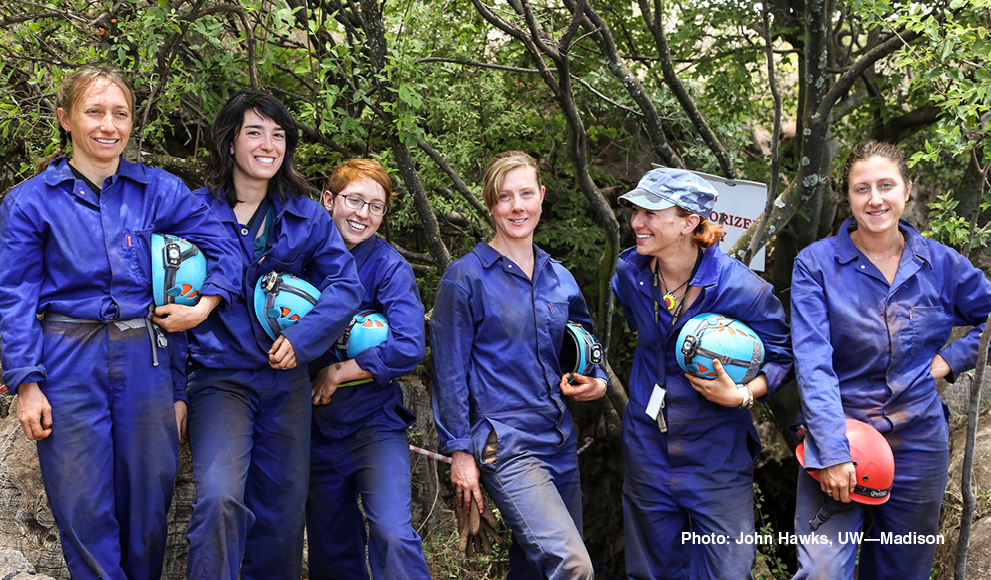Ali Gurtov ’07 Is One of The Rising Star Expedition’s "Underground Astronauts"

In 2013, in a cave known as Rising Star near Johannesburg, South Africa, an international team of scientists began the process of uncovering more than 1,500 well-preserved bones and teeth. The discovery of the fossils, hidden in a barely accessible chamber, adds a new branch to the human family tree: a creature dubbed Homo naledi. Papers detailing the team's findings have just been published, as reported yesterday by National Geographic, the New York Times, and other media.
Alia Gurtov ’07 was one of six women chosen to join the expedition as a result of some unique qualifications. The chamber where the bones were found was accessible only through an extremely narrow chute. Lead researcher Lee Berger, a National Geographic Explorer-in-Residence and professor at the University of Witwatersrand in Johannesburg, had sent out a call through social media looking for explorers with: a master’s degree or higher in palaeontology, archeology or an associated field; caving experience; and the ability to fit through an 18-centimeter (about 7-inch) space. Gurtov and five other women who met these qualifications were chosen from a pool of some 50 applicants and became known as the team’s “underground astronauts.”
“It wasn’t until the first time I entered the hominin chamber that the enormity of this discovery hit me and I had to take several deep breaths to keep from blurring my vision,” Gurtov told us in a 2013 interview. “The quantity of ancient human bones lying on the surface [was] enough to drop anyone’s jaw, including the hominin whose hemi-mandible we picked up first. Dr. Berger has described our careful tiptoeing around fossils as a moonwalk in low gravity.”
In a recent email, she said, "I can thank Wellesley College for setting me on this wild paleoanthropological journey. My professors during my time as a student, and the professors there now, have been the kind of mentors I would wish for every young scientist. Thanks to their encouragement and guidance, I was able to fill my CV with half a dozen archaeological excavation seasons before I began my MA. My participation in international research is a large part of what earned me spots on the Rising Star Excavation and Workshop. I couldn't be more grateful."
Gurtov earned master’s degrees in archaeology from Leiden University, Netherlands, and in anthropology from the University of Wisconsin–Madison. She is now a Ph.D. candidate in anthropology at UW–Madison. After graduating from Wellesley, she spent one year as a Thomas J. Watson Fellow researching the intersection of nationalism and paleoanthropology in Europe, Asia and Africa, and participated in Pleistocene excavations at Neumark-Nord, Germany, and Pinnacle Point, South Africa.
Gurtov worked with Philip L. Kohl, Kathryn Wasserman Davis Professor of Slavic Studies and professor of anthropology, while at Wellesley. “Phil Kohl, my adviser, encouraged me to apply for grants; arranged my field season at Dmanisi, Georgia; and gave me all the time and support I could have asked for. Wellesley as a whole provided the environment I needed to develop as a researcher, surrounded by active professors and devoted colleagues,” Gurtov said in 2013. She has since worked with other members of the faculty in her professional career.
“Alia has really done amazing things as a graduate student,” said Adam Van Arsdale, Whitehead Associate Professor of Critical Thought and associate professor of anthropology. “Even prior to this exciting project in South Africa, she had an accomplished record of field work in Europe and Tanzania as part of her master’s (in the Netherlands) and now doctoral work (at the University of Wisconsin-Madison). Alia demonstrates the kind of independent drive we hope to instill in all of our students.”
About the discovery, Van Arsdale said, “These fossil finds are extremely significant. The site’s initial fossil yield is more than 1,500 hominin fossils, making it the largest single fossil hominin find from the continent of Africa.”
Van Arsdale studies the early evolution and dispersal of the genus Homo but was not directly involved with the Rising Star expedition. He said, “We still have a lot more to learn about these fossils, their context, and exactly where they fit in the story of our lineage, but the size and quality of the sample will keep researchers busy for years and play a major role in ongoing debates about the origin of the genus Homo.”
To learn more about the Rising Star Expedition and the discovery of Homo naledi, read the National Geographic blog and the October National Geographic cover story.
